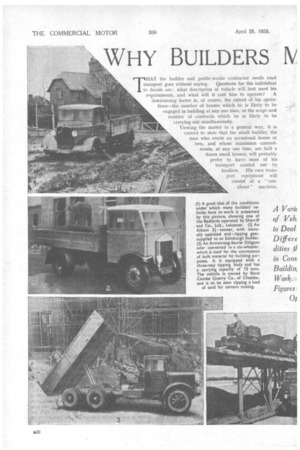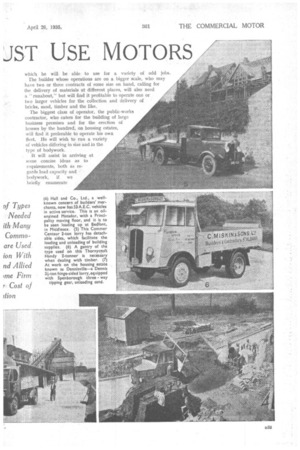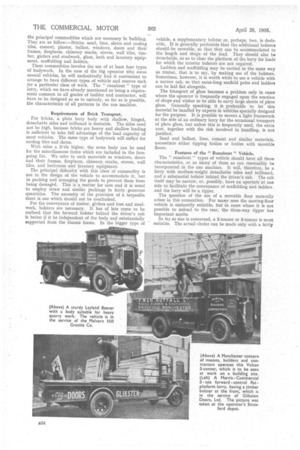WHY BUILDERS IV
Page 50

Page 51

Page 52

Page 53

If you've noticed an error in this article please click here to report it so we can fix it.
JST USE MOTORS TtHAT the builder and public-works contractor needs road transport goes without saying. Questions for the individual o decide are : what description of vehicle will best meet his
requirements, and what will it cost him to operate? A determining factor is, of course, the extent of his operations—the number of houses which he is likely to be engaged in building at any one time, or the scope and number of contracts which he is likely to be carrying out simultaneously.
Viewing the matter in a general way, it is correct to state that the small builder, the man who erects an occasional house or two, and whose maximum commitments, at any one time, are half a dozen small houses, will probably prefer to have most of his transport carried out by hauliers. His own transport equipment will consist of a " runabout " machine, which he will be able to use for a variety of odd jobs.
The builder whose operations are on a bigger scale, who may have two or three contracts of some size on hand, calling for the delivery of materials at different places, will also need a "runabout," but will find it profitable to operate one or two larger vehicles for the collection and delivery of bricks, sand, timber and the like.
The biggest class of operator, the public-works contractor, who caters for the building of large business premises and for the erection of houses by the hundred, on housing estates, will find it preferable to operate his own fleet. He will wish to run a variety of vehicles differing in size and in the • type of bodywork.
It will assist in arriving at some concise ideas as to requirements, both as regards load capacity and bodywork, if we briefly enumerate the principal commodities which are necessary in building. They are as follow:—Bricks, sand, lime, slates and roofing tiles, cement, plaster, ballast, windows, doors and their frames, fireplaces, chimney stacks, stoves, wall tiles, timber, girders and steelwork, glass, bath and lavatory equipment, scaffolding and ladders.
These commodities involve the use of at least four types of bodywork. In the case of the big operator who owns several vehicles, he will undoubtedly find it convenient to arrange to have different types of vehicle and reserve each for a particular class of work. The " runabout" type of lorry, which we have already mentioned as being a requirement common to all grades of builder and contractor, will have to be designed so as to embody, so far as is possible, the characteristics of all patterns in the one machine.
Requirements of Brick Transport.
For bricks, a plain lorry body with shallow, hinged, detachable sides and tailboard is desirable. The sides need not be high, because bricks are heavy and shallow loading is sufficient to take full advantage of the load capacity of most vehicles. The same type of bodywork will suffice for roofing tiles and slates.
With sides a li tie higher, the same body can be used for the miscellaneous items which are included in the foregoing list. We refer to such materials as windows, doors and their frames, fireplaces, chimney, stacks, stoves, wall tiles, and bathroom and lavatory equipment.
The principal difficulty with this class of commodity is not in the design of the vehicle to accommodate it, but in packing and arranging the goods to prevent them from being damaeed. This is a matter for care and it is usual to employ straw and similar packings in fairly generous quantities. The necessity of the provision of a tarpaulin sheet is one which should not be overlooked.
For the conveyance of timber, girders and iron and steelwork, bolsters are necessary. It has of late come to be realized that the forward bolster behind the driver's cab is better if it be independent of the body and substantially supported from the chassis frame. In the bigger type of vehicle, a supplementary bolster or, perhaps, two is desirable. It is generally preferable that the additional bolsters should•be movable, so that they can be accommodated to the length and shape of the load. They should also be detachable, so as to clear the platform of the lorry for loads for which the interior bolsters are not required.
Ladders and scaffolding may be carried in the same way as timber, that is to say, by making use of the bolsters. Sometimes, however, it is worth while to use a vehicle with a narrow cab, so that extra-long scaffold poles and ladders can be laid flat alongside.
The transport of glass becomes a problem only in cases where the operator is frequently engaged upon the erection of shops and wishes to be able to carry large sheets of plate glass. Generally speaking, it is preferable to let this material be handled by experts in vehicles specially designed for the purpose. It is possible to mount a light framework at the side of an ordinary lorry for the occasional transport of plate glass, but unless this is frequently used, the extra cost, together with the risk involved in handling, is not justified.
Sand and ballast, lime, cement and similar materials, necessitate either tipping bodies or bodies with movable floors.
Features of the " Runabout " Vehicle.
The " runabout" types of vehicle should have all these characteristics, or as many of them as can reasonably be incorporated in the one machine. It will, therefore, be a lorry with medium-weight detachable sides and tailboard, and a substantial bolster behind the driver's cab. The cab itself may be narrow, or, possibly, have an aperture at one side to facilitate the conveyance of scaffolding and ladders. and the lorry will be a tipper.
The question of the use of a movable floor naturally arises in this connection. For many, uses the moving-floor vehicle is eminently suitable, but in cases where it is not possible to unload to the rear, the three-way tipper has important merits.
So far as size is concerned, a 2-tonner or 3-tonner is most suitable. The actual choice can be made only with a fairly
accurate knowledge of the conditions. A comparatively small operator whose work is carried on close to his headquarters' will find a 2-tonner adequate. If he usually has to go fairly far afield, he may find it better to use a 3-tanner. This size of lorry will, in any event, be the best choice for a builder, with the need for transport facilities, whose scope is somewhat above the lowest limit in respect of commitment's.. A 2-tOnner, equipped, as above destribed, with a threeway tipping body .and a substantial bolster, will cost about 4300. Its operating cost will be somewhat above the average in respect of most of the usual items, because building and contracting work is generally recognized to be more exigent than others in its demands on vehicles.
Fuel consumption.at the rate of about 12 m.p.g. can be taken as a_ fair average. Tyre costs are a little higher than usual. A. fair schedule of running costs per mile is as follows:—Fuel, 1.25d.; lubricants, 0.10d.; tyres, 0.50d.; maintenance, 0.75d.; depreciation, 0.50d.; total; 3.1d. per mile.
Arriving at the Weekly Costs.
The weekly costs (standing charges) will approximate to the following:—Road Fund licence, 10s.; wages, 22 10s.22 17s. 6d., according to district; insurance, 8s.-10s.; garage, 5s.; interest on first cost, 3s.; total, £3 16s.£4 5s. fid., say, an average of 24 per week. Allowing for a mileage of about 200 per week, the total cost is 26 1 Is. 8d. per week.
From this total, a fair amount may be deducted to allow for the fact that the driver, in between hauls, does miscellaneous work in loading and unloading, sorting and so on, which must be credited to the cost of the vehicle.
An important point to remember is that any extra mileage over and above the 200 suggested is accomplished at small cost—not more than 3d. per mile. To fetch 1,000 bricks, for example, from the station or brickfield, say, five miles away, costs only 2s. 6d.—a definite saving. Collections' of other materials can, in the same way, be carried out at correspondingly small cost. What is more to the point, these collections and deliveries of commodities to any site can be effected just as and when required, without dependence upon the capacity Of the supplier to make deliveries when they happen to be required.
Corresponding figures_ of cost for the 3-tonner show a total of 3.60d. per Mile for the running costs and £4 5s. per week for "the standing charges. The grand total, on the basis of 200 miles per Week, -is 27 5s. The same remarks apply here, as in the case of the 2-tonner, relating to the need for credit on account of the driver's activities, the low cost of mileage over and above the minimum 200 and the convenience of being able to make collections and deliveries as desired.
The Value of the Moving Floor.
The biggest class of operator will probably find the opportunity of making more extensive use of the movable floor amongst a varied fleet It is applicable to both the loading and unloading of all kinds of material 'and,' with the possible exception of timber and scaffolding; there is not one of the commodities above enumerated which cannot be more conveniently handled on a vehicle thus equipped. The contractor, in his choice of larger vehicles, will inevitably come to use six-wheelers. He will be bound to do so, if, as is likely, he wishes to carry 12 tons (4,0005,000) of bricks direct from brickfields to the various sites where he is engaged,
Costs for all types of vehicle are, of course, given in The Commercial Moto,r Tables of Operating Costs. A typical figure of interest to the big contractor is that of a 12-ton oil-engined six-wheeler, which, covering 1,000 miles per week, will cost .240. In that time, it may have collected 24,000-25,000 bricks from a point 80400 miles away, at a net cost of 33s.-35s_ per 1,000 bricks.




































































































